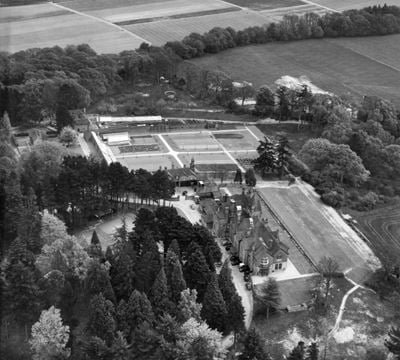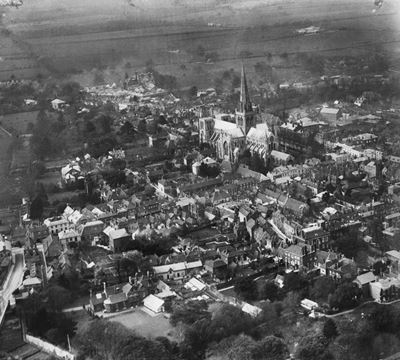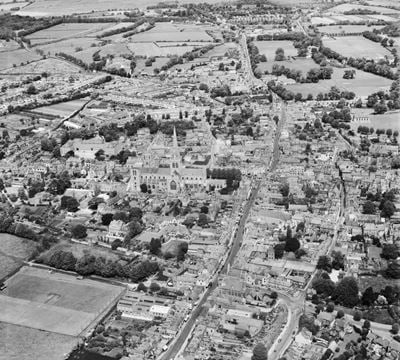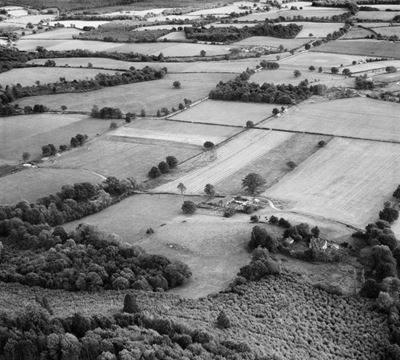Chichester
Explore hidden histories, historic photos, and things you never knew about Chichester from the collections and archives of Historic England.
Discover your local listed buildings and places
Introducing some of Chichester's most historic sites, included in the National Heritage List for England. Some of these captions have been summarised by AI. Click through for the official List entry. Skip this section and go to place by numbers
Fishbourne Roman Palace
Fishbourne
Fishbourne Roman Palace, occupied since 43 AD and expanded by AD 75, was constructed on a former military site possibly for King Togidubnus.
Pitshill and the Manor of Dean
Tillington
Pitshill estate includes a Grade II* listed 18th-century house set within mid-19th-century gardens and parklands, historically associated with the Mitford family.
Roman amphitheatre
Chichester
The Chichester Roman Amphitheatre, a rare monument, served as a major entertainment center reflecting Roman culture and history in the regional capital, Noviomagus Regnensium.
Former Singleton Railway Station
West Dean
Former railway station of 1880, by T H Myres, consisting of the station house, toilet block and a water tower.
Petworth House
Petworth
Petworth House features 16th and 17th-century landscaped grounds by Lancelot Brown, historically linked to the Percy family, Somerset Duke, and artist J.M.W. Turner.
Blackdown Park
Lurgashall
Blackdown Park, an early to mid-19th-century garden, features historic elements from the 18th century and earlier, enriched with 20th-century additions, located near Haslemere.
The Devil's Jumps round barrow cemetery
Elsted and Treyford
The Devil's Jumps round barrow cemetery is a well-preserved Bronze Age site featuring rare bell barrows and common bowl barrows, indicating aristocratic and diverse burial practices.
Lavington Park
Duncton
Lavington Park's estate dates back to the late 16th century, with developments in the 18th and 19th centuries, notable for historical figures like Bishop Wilberforce and Cardinal Manning.
HMS/m A1
Eastern Solent, Off East Wittering, West Sussex
HMS A1, the first British designed submarine, sank twice: once in 1904 after a collision and permanently in 1911 as a target. Discovered in 1989.
Goodwood House
Boxgrove
Goodwood House features an 18th-century garden, expanded with ornamental and late 20th-century additions, within a historic park of medieval origin associated with the Dukes of Richmond.
King Edward VII Hospital
Easebourne
King Edward VII Hospital was a tuberculosis sanatorium founded by King Edward VII in 1906, featuring gardens designed by Gertrude Jekyll for therapeutic activities.
Stansted Park
Stoughton
Stansted Park features gardens and parkland dating from the late 17th century, developed further through the centuries with contributions from notable figures like Lancelot Brown.
Roman road at Chapel Common
Milland
Roman roads, essential for Roman mail and commerce, remain well-preserved at Chapel Common, offering insights into Roman engineering and historical land use.
The Vandalian Tower, Up Park
Harting
The Vandalian Tower in Uppark is a notable part of an 18th-century garden designed by Lancelot Brown, symbolizing its owner's status and linked to the Hellfire Club.
West Dean College West Dean Park
West Dean
West Dean College was originally built by James Wyatt for Lord Selsey in 1804 and later expanded. King Edward VII frequently visited William James here.
Uppark (National Trust)
Harting
Uppark, built around 1689 by Ford Lord Grey of Warke, features interior decor from the 1770s. Emma Hart, Lady Hamilton, and H.G. Wells were notable residents.
Burton Park
Barlavington
Burton Park features 19th and early 20th-century gardens in an 18th-century park. Historically owned by prominent families, it now serves private residential purposes.
The Fox Goes Free
Singleton
Inn, mainly C17, though thought to have C16 origins, and with additions and alterations of subsequent centuries.
The Hazardous (formerly Le Hazardeux)
Bracklesham Bay, off West Sussex
Remains of 1706 wreck of a British Third Rate ship of the line which was beached in Bracklesham Bay during a storm.
West Dean
Lavant
West Dean, an estate developed from the 19th century, features ornamental gardens and an arboretum. Historically owned by notable families, it now hosts an educational foundation.
Watch Office (Control Tower), former RAF Tangmere
Tangmere
Watch office (control tower) of 1944 to the former RAF Tangmere airbase.
Chichester Castle
Chichester
Chichester Castle is a significant medieval motte and bailey fortification, reflecting Norman military strategy and feudal administration.
Chichester Signal Box
Chichester
Signal box, 1882 for the London, Brighton & South Coast Railway on the Brighton and Portsmouth Railway.
Cowdray House
Easebourne
Cowdray House is a historic site featuring Tudor ruins and gardens, extensively modified in the 18th century by Lancelot Brown, known for its cultural and historical landscape.
Assemblage of Second World War Tanks and Bulldozers
Approximately 10km south of Selsey Bill (NGR SZ807208314) at a depth of between 15m and 20m. The vehicles are dispersed throughout an area of around 30m by 25m.
On the night of the 5/6 June 1944, Landing Craft LCT(A) 2428 broke down in the south-eastern approaches to the Solent while on route to the D-Day landings in Normandy.
Uppark
Compton
Uppark is a historic estate noted for its 18th-century gardens, developed by figures like Ford Grey, Lancelot Brown, and Humphry Repton, and its ongoing care by the National Trust.
The Trundle hillfort, causewayed enclosure and associated…
Lavant
The Trundle hillfort and Neolithic causewayed enclosure at St Roche's Hill reflect Iron Age societal structures and Neolithic ceremonial practices, highlighting historical and archaeological...
Roman Catholic Church of St Richard
Chichester
Roman Catholic Church built in 1958 to the design of Tomei and Maxwell of London; builder Messrs A Booker and Son of Walberton; stained glass by Gabriel Loire and paintings by David...
The former King Edward VII Hospital
Easebourne
The former King Edward VII Hospital, designed by Charles Holden, was built in 1903-6 as a tuberculosis sanatorium, funded by Sir Ernest Cassel, and influenced later hospital designs.
The John Edes House
Chichester
The John Edes House, built in 1696, is a red brick structure with Portland stone dressings, featuring a notable pediment and original casement windows with leaded panes.
Cooke's House
Bury
Cooke's House is a 16th-century two-story manor with gardens designed in the early 20th century, featuring formal compartments and a notable rose garden.
Greyfriars Chapel, Priory Park
Chichester
The Franciscan Friary Church, with its well-preserved remains, serves as an educational and recreational resource, representing a major medieval religious institution in Priory Park.
Harting Beacon: a hilltop enclosure, Anglo-Saxon burial m…
Elsted and Treyford
Harting Beacon includes a Bronze Age hilltop enclosure, an Anglo-Saxon burial mound, and a Napoleonic telegraph station, illustrating its strategic importance across periods.
Causewayed enclosure, World War II searchlight emplacemen…
Boxgrove
The monument on Halnaker Hill includes a Neolithic causewayed enclosure and World War II searchlight emplacements, illustrating its long-term strategic importance and historical...
Vicar's Hall and Crypt
Chichester
Vicar's Hall and Crypt features a late 12th-century undercroft and a late 14th-century hall with an open timber roof, forming a group with Canon Gate and nearby properties.
Bell Tower of the Cathedral
Chichester
The Bell Tower of the Cathedral is a late 14th or early 15th-century sandstone structure and England's only detached cathedral bell tower.
Explore more
Search for more listed placesChichester through time
This timeline shows the first period of use for buildings and places on the National Heritage List for England, just one of the details recorded for every list entry. Click around to see how Chichester changes over time. Skip this section and go to aerial photos
Prehistoric Before AD 43
Prehistory covers a million years of human occupation before the Roman invasion, from hunter-gatherers of several human species, including Neanderthals, to more recent herders and farmers. It was a time of developing technologies and belief systems, involving contact with and migration from Europe, all reflected in the variety of artefact and monument types characteristic of particular prehistoric periods.
Roman AD 43 to AD 410
Britain was invaded by four legions of the Roman army in AD 43, who relatively rapidly conquered England from landing points in Kent. Parts of Wales and Scotland soon followed.
Roman culture brought urbanism, monumental buildings, wide-ranging religious beliefs, writing, and strong social hierarchy. The Roman administrative system was withdrawn in AD 410.
Early medieval AD 410 to AD 1066
This period, often associated in England with Anglo-Saxons and Vikings, saw a reduction in urban living from the Roman period and increased migration from northern Europe.
Traces of this period can be found in cemeteries, particularly in artefacts and in some of the very early churches, as this period also saw the growth of Christianity in Britain.
Medieval AD 1066 to AD 1540
This period, sometimes known as the Middle Ages, began with the Norman invasion in AD 1066. It saw a significant rise in military and defensive buildings such as castles and earthworks, as well as religious houses dominating a largely agricultural landscape.
The monarchy and Church dominated the period, which also saw the break with the Roman Catholic Church and the English reformation.
Post medieval AD 1540 to AD 1901
The Post-Medieval period brought seismic changes to life in England, with religious reformation leading to the democratization of worship and the destruction of hundreds of religious houses.
In parallel, there was a huge expansion of scientific study and enlightenment that permanently altered the nation's social structure and landscape. Industrialization and mass production lead to wider global trade, emigration, and immigration.
20th century AD 1901 to AD 2000
The 20th century saw an incredible expansion of England's transport networks, with suburban growth shadowing rapid infrastructural expansion. The establishment of state schools, hospitals, and modern technical colleges, with new architectural styles, radically changed the appearance of towns and cities.
Two catastrophic world wars and the 1918 pandemic also brought unprecedented change, altering England's built environment and social structures forever.
Prehistoric Before AD 43
Prehistory covers a million years of human occupation before the Roman invasion, from hunter-gatherers of several human species, including Neanderthals, to more recent herders and farmers. It was a time of developing technologies and belief systems, involving contact with and migration from Europe, all reflected in the variety of artefact and monument types characteristic of particular prehistoric periods.
Roman AD 43 to AD 410
Britain was invaded by four legions of the Roman army in AD 43, who relatively rapidly conquered England from landing points in Kent. Parts of Wales and Scotland soon followed.
Roman culture brought urbanism, monumental buildings, wide-ranging religious beliefs, writing, and strong social hierarchy. The Roman administrative system was withdrawn in AD 410.
Early medieval AD 410 to AD 1066
This period, often associated in England with Anglo-Saxons and Vikings, saw a reduction in urban living from the Roman period and increased migration from northern Europe.
Traces of this period can be found in cemeteries, particularly in artefacts and in some of the very early churches, as this period also saw the growth of Christianity in Britain.
Medieval AD 1066 to AD 1540
This period, sometimes known as the Middle Ages, began with the Norman invasion in AD 1066. It saw a significant rise in military and defensive buildings such as castles and earthworks, as well as religious houses dominating a largely agricultural landscape.
The monarchy and Church dominated the period, which also saw the break with the Roman Catholic Church and the English reformation.
Post medieval AD 1540 to AD 1901
The Post-Medieval period brought seismic changes to life in England, with religious reformation leading to the democratization of worship and the destruction of hundreds of religious houses.
In parallel, there was a huge expansion of scientific study and enlightenment that permanently altered the nation's social structure and landscape. Industrialization and mass production lead to wider global trade, emigration, and immigration.
20th century AD 1901 to AD 2000
The 20th century saw an incredible expansion of England's transport networks, with suburban growth shadowing rapid infrastructural expansion. The establishment of state schools, hospitals, and modern technical colleges, with new architectural styles, radically changed the appearance of towns and cities.
Two catastrophic world wars and the 1918 pandemic also brought unprecedented change, altering England's built environment and social structures forever.
Aerial photos of Chichester
Aerial photography helps reveal secrets of England's changing landscapes that are impossible to see from the ground. Skip this section and go to archive images

Chichester
Chichester Cathedral and the city centre, Chichester, 1938

Chichester
The Wingard (M.A.) Ltd Factory and Chichester Cathedral, Chichester, 1948

Fernhurst
Plant Protection Ltd Fernhurst Research Station at Verdley Place and environs, Fernhurst, 1951

Fernhurst
Plant Protection Ltd Fernhurst Research Station at Verdley Place, Fernhurst, 1951

Chichester
Chichester Cathedral, Chichester, 1920

Chichester
Chichester Cathedral and the town, Chichester, 1950

Westhampnett
Westhampnett, Goodwood Motor Circuit on a race day, 1949

Westhampnett
Westhampnett, Goodwood Motor Circuit on a race day, 1949

Upper Wardley
Wardley Cottage, Upper Wardley, 1953

Upper Wardley
Wardley Cottage, Upper Wardley, 1953
Chichester in the Historic England Archive
The Historic England Archive cares for over 15 million images, dating from the 1850s to the present day. Discover stunning images of Chichester's past. Skip this section and go to stories about heritage
Charles George Harper Collection
Chichester, West Sussex
Date created: 1892 - 1933
A view from the east of the Market Cross, with the spire of Chichester Cathedral in the background
Eric de Mare
Chichester, West Sussex
Date created: 1961 - 1980
Exterior view of the Chapel at Bishop Otter Teacher Training School in Chichester showing a glass gable.
John Gay Collection: London
Richmond Park, Kingston Upon Thames, Greater London Authority
Date created: Jan 1962 - May 1964
A herd of deer lie on the grass in the shade at Richmond Park.
John Gay Collection: Rural Life
Chichester, West Sussex
Date created: 1950 - 1960
A view from an elevated position of a large group of people dancing on the lawn in front of the south facade of Bishops Palace, Chichester, with the...
John Gay Collection: Counties
Chichester, West Sussex
Date created: Early 1950s
A young boy sitting on a flight of steps leading up to Cowdray House, with people walking by
John Laing Collection
Chichester, West Sussex
Date created: 20 Aug 1984
A worker carrying out guniting (spraying concrete) on the Southern gas pipeline
Charles George Harper Collection
East Hampshire, Hampshire
Date created: 1892 - 1933
The south elevation of the Manor House, seen from the south-west
Eric de Mare
Chichester, West Sussex
Date created: 1961 - 1980
Exterior detail view of the Chapel at Bishop Otter Teacher Training School in Chichester showing a sculpture on the wall.
John Gay Collection: London
Richmond Park, Kingston Upon Thames, Greater London Authority
Date created: Jan 1962 - May 1964
A herd of deer lie in the long grass at Richmond Park.
John Gay Collection: Rural Life
Chichester, West Sussex
Date created: 1950 - 1960
A view looking down onto a presentation during a fete held at Bishops Palace, Chichester, with onlookers seated and standing in a semi-circle on the...
John Gay Collection: Counties
Chichester, West Sussex
Date created: Early 1950s
A young boy sitting on a flight of steps leading up to Cowdray House.
John Gay Collection: Rural Life
Chichester, West Sussex
Date created: 1950 - 1960
A view from an elevated position of a large group of people dancing on the lawn in front of the south facade of Bishops Palace, Chichester, with the...
Stories about heritage in your local area
Historic England publishes news, blogs, research, videos, and podcasts celebrating England's rich heritage. Discover the stories we have about Chichester. Skip this section and go to education
10 Brilliant Historic Bookshops
Mentions The Former Church of St Olave
We love any excuse to celebrate a bookshop, with their comforting atmosphere and wonderful smell. Here are some highlights from around the country.
A Brief Introduction to the Women’s Institute
Mentions The Fox Goes Free
Britain’s first WI was formed in Wales in September 1915, and the first in England followed soon afterwards, at Charlton, West Sussex.
8 Cutting-Edge Libraries of the Late 20th Century
Mentions West Sussex Library
Discover some of England’s listed modern libraries
Fishing for Heritage
Mentions Chichester
Maritime archaeologists worked with fishermen to investigate underwater heritage off the Sussex coast, including a crashed US military aircraft.
Back Issues of Historic England Research
Mentions Chichester
Here you can download back issues of Historic England Research magazine and its predecessor Research News.
Gods and Goddesses, Heroes and Heroines in the Nene Valley
Mentions Chichester
The discovery of an important group of Roman sculpture fragments in the Nene Valley.
The Lost Roman Road From Chichester To Arundel
Mentions Chichester
Analysis of lidar and aerial photography leads to the rediscovery of a long-speculated route of a Roman Road.
Research Reports Roundup to February 2024
Mentions Chichester
A roundup of new additions to the Historic England Research Reports database and a longer term overview of industrial heritage reports.
Unusual Second World War Sites Listed and Upgraded to Mark the 80th Anniversary of the Battle of Britain
Mentions The former Spitfire Club, RAF Tangmere, RAF Tangmere: Barrack Block (Building 116) to the Former RAF Airbase, Watch Office (Control Tower), former RAF Tangmere
Four new listings are highlighted alongside three other sites either upgraded or re-listed which show how the Battle has left its mark across England.
Britain’s Earliest Easter Bunny Found at Roman Palace
Mentions Fishbourne Roman site, Fishbourne Roman Palace
Experts have made a discovery which reveals rabbits came to England 1,000 years earlier than previously thought.
New Poll Shows Strong Public Popularity for Conservation Areas - 50 Years After They Were Introduced
Mentions Chichester
Findings released on anniversary of the first Conservation Area, Stamford in Lincolnshire, designated in 1967 - there are now more than 10,000 Conserv
Four Buildings Re-listed to Celebrate Their Role in the History of the Women’s Institute
Mentions The Fox Goes Free
The re-listings of four buildings celebrate the story of the WI and mark the centenary of the first WI meeting in England.
British Library Listed at Grade I
Mentions West Sussex Library, Chichester
The British Library and seven local libraries across England are being listed as the best examples of public libraries of the later 20th century.
Chichester's social history through photos
Over 10,000 images from the Historic England Archive have been specially selected and re-captioned for teachers, students, and anyone who wants to learn more about their local area. Skip this section and go to grant-aided places
Yeoman's House, Bignor, West Sussex
Period: Tudor (1485 - 1602)
The Yeoman's House dates is a 15th-century thatched and timber-framed cottage with jettied overhangs.
Yeoman's House, Bignor, West Sussex
Windmill, Birdham, West Sussex
Period: 1930s (1930 - 1938)
This small smock mill was constructed alongside a chicken run and was only one year old when this picture was taken in 1936.
Windmill, Birdham, West Sussex
West Ashling Mill, Funtington, West Sussex
Period: 1930s (1930 - 1938)
Also known as Hackett's Mill.
West Ashling Mill, Funtington, West Sussex
Tudor House, Petworth, West Sussex
Period: Stuart (1603 - 1713)
This house, together with Squire's Holt on Church Street, formed a large house which was the home of the Daintrey family.
Tudor House, Petworth, West Sussex
Tags
The Yeoman's House, Bignor, West Sussex
Period: Medieval (Middle Ages) (1066 - 1484)
A detail of the exterior showing wattle and daub panels.
The Yeoman's House, Bignor, West Sussex
Period: Medieval (Middle Ages) (1066 - 1484)
A detail of windows and timber framing.
The Royal West Sussex Hospital, Chichester, West Sussex
Period: Georgian (1714 - 1836)
This is a very fine building. Built in 1825 it originally had only 2 storeys the third was added in the late 19th century.
The Royal West Sussex Hospital, Chichester, West Sussex
The Old Girls School, Petworth, West Sussex
Period: Georgian (1714 - 1836)
The Old Girls School was originally built as a Unitarian chapel in 1819.
Discover more
Ready for more local stories? Take a look at these other places nearby


